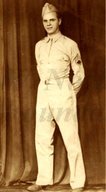
|

|
|
|
|
Giambattista was born in Brooklyn, New York, to Carlo, a master cabinetmaker, and Mary. Both were immigrants from Naples who met in the United States. Giambattista, also called John, was one of 10 children. "It was tough. You never got enough to eat," he says of the Depression. The family spoke Italian in the house. His father expected the children to work. "On my seventeenth birthday instead of saying, `Happy Birthday, John,' he said, `You're seventeen today. Turn your books in and go find a job.' That was my birthday," he recalls. He earned seven dollars a week making glassine paper bags, and gave his father his wages. Mario gave him fifty cents back. John joined the U.S. Army in July of 1940. After training at Camp Upton he was sent to Panama and assigned to Company L of the Fifth Infantry Regiment. He continued infantry training tactics in Panama, where he remained for three years. Suffering from back problems, John was sent to cooking school. He was returned to the states and sent to Camp Shelby near Hattiesburg, Mississippi, and then to Fort Custard, a training school for military police. At that camp, near Ruston, Louisiana, he worked with German prisoners from the Afrika Corps. John was serving as mess sergeant for his unit that moved the prisoners from Ruston to Tallulah. There the Germans picked cotton and were paid a penny a pound. "In the compound we ran a little store where they could buy cigarettes for a nickel a pack. We even sold beer for ten cents a bottle. So if they picked a hundred pounds of cotton that day they could have a pack of cigarettes and a couple of beers," he recalls. In Tallulah he met and married Verbie Elaine Bradley on April 1, 1944. The couple later would have two children, three grandchildren, and two great-grandchildren. By 1994 his unit began transatlantic trips to pick up Axis prisoners in England and take them to America. He says British citizens often demonstrated their disdain for the prisoners. "They emptied their poop buckets, threw things at them--rocks--run out and hit them. We had to guard the prisoners to keep Englishmen off them. That was a chore," he recalls. Just before arriving in New York, the captain ordered all the sergeants to place the prisoners on deck as the ship entered the harbor where they could see the Statue of Liberty and the New York skyline. "I said `What's the matter, captain?' He said, `Hitler told the people in Germany that he had bombed New York. There was no Statue of Liberty. There was no New York. He said now these boys are going to write home and say Hitler is full of poop,'" John recalls. He made three trips ferrying prisoners to the United States before finally going into France. His unit supported the Ninety-fourth Infantry Division as they fought into Germany and captured more Germans. "They loved being prisoners," he says of the German soldiers. "They were out of the war." He noticed the German soldiers were getting younger. "Age sixteen, seventeen year olds, just kids," he recalls. Soon after the war ended he had more than enough points (120) to be sent home. He sailed on the Joseph B. McGuire, a Liberty ship, and was discharged at Fort Dix, New Jersey. John worked at several jobs before re-entering the U.S. Army and serving in Germany, then in Korea several years after the conflict. He retired after twenty years of service and moved to Delhi, Louisiana, where he opened a furniture repair and upholstery business. |


